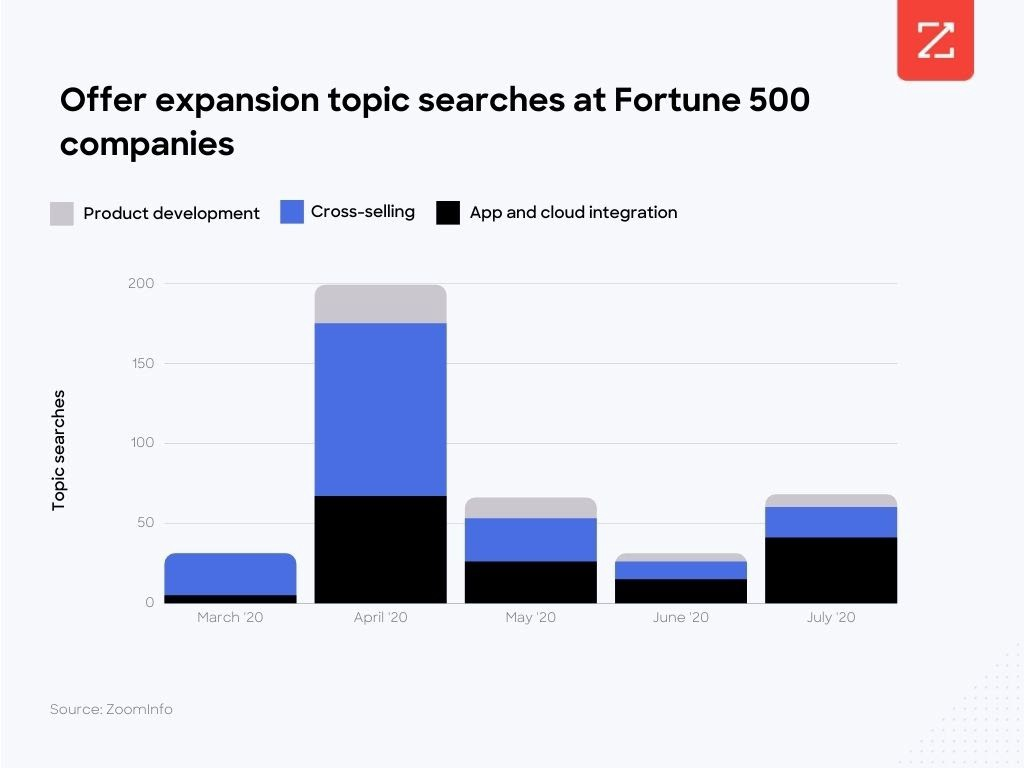“Do you want fries and a coke with that?” — we’ve all had the ultimate cross-selling experience at McDonald’s.
Not to mention the temptation of Amazon’s ‘frequently bought together’ section.
As a consumer, you know that cross-selling works. It works so well that Amazon once claimed up to 35% of its revenue comes from cross-selling.
Last year? They saw a 37.4% increase in revenue to a record $96.15 billion.
But how do you know when your B2B customer is indicating sales-readiness for cross-selling opportunities? Let’s take a look at the signals that indicate it’s time to cross-sell.
What is Cross-Selling?
Simply put, cross-selling is a sales technique that encourages customers to purchase a product or service that is related to a purchase they already plan to make.
For example, if you offer a customer that is purchasing a smartphone the option to also purchase headphones at the same time, you are cross-selling them a related product.
When cross-selling to a customer, it’s important to make sure that the products you offer them at the point of sale are ones that they would deem necessary to improve their experience with their primary purchase.
If nothing else, 2020 really shed a light on the importance of cross-selling as a revenue generator in businesses.

How Do You Know When To Cross-Sell?
Timing is important when making the most of a cross-selling opportunity.
Several factors can be tracked when trying to get a clear indication of when to cross-sell to your customers.
Persona Actions and Customer Journey Analytics
Analyzing the customer journey for each of your personas can reveal which touchpoints in the funnel are prime opportunities to cross-sell complementary products or services.
The more data your marketing and sales organizations collect about your persona’s behavior, the easier it will be to get your timing and messaging right. In the long run, it can also help you incorporate cross-sales into your sales forecast.
Cross-Sell Analysis
Cross-sell analysis can help to enhance marketing campaigns by revealing which complementary products or services are likely to be bought together. Typically, cross-selling ideas are based on a set of association rules that provide a lift ratio. Lift ratios above 1.0 indicate that the rule is valid. The idea is to build out a cross-selling strategy based on the findings of your cross-sell analysis and to continuously improve it.
During the pandemic, are people still: Releasing new products? Building new partnerships? Cross-selling and up-selling? Surprisingly, yes, yes, and yes. More on this–and all things offer expansion–in this month’s upcoming content. https://t.co/sR5eAnFdqmpic.twitter.com/dLyIYpLOiU— ZoomInfo (@ZoomInfo) November 12, 2020
How Does Cross-Selling Increase Customer Lifetime Value?
Essentially, cross-selling increases revenue because it immediately increases sales.
Cross-sales increase the value of an average customer order. When you combine this with research which shows that the probability of selling to a new prospect is 5-20%, compared to 60-70% for an existing customer. Trying to cross-sell is a complete no-brainer.
Integrating Cross-selling Into Your Marketing And Sales Processes
Taking cross-selling seriously can have a big impact on your business’ bottom line. It’s a good idea to start layering your marketing and sales strategies with cross-selling techniques and using customer data to maximize cross-sales. Here are some considerations when integrating cross-selling into your sales and marketing processes:
Customer Relationship Management Tool
Customer relationship management tools are essential to creating a central database where you can track customer and prospect data, customer interactions, and provide multiple teams within your organization with access to this information.
CRM tools are a necessity in today’s digital-first marketing landscape. Once you have integrated it into your sales and marketing processes, it pays to do the additional work to identify behaviors that trigger cross-selling tactics and automate actions based on them.
Targeted Advertising
Targeted, or programmatic advertising makes use of a prospect’s attributes and behavior to serve them with relevant ads for your product or service.
Creating targeted advertising campaigns that do the same to offer complementary products and services to your primary value proposition through cross-selling can also increase revenue.
Inbound marketing
Cross-selling can also be included within parts of your company’s inbound marketing efforts.
For example, creating content that explains the value proposition of complementary products that would improve the customer’s experience with the primary product or service can be a part of your content marketing strategy.
Community Management
Employing cross-selling tactics within your community management processes is also a way to expose customers to the idea of complementary products and services that work well with your primary offering.
This is an especially good way to speak to a pool of interested customers all at the same time via social channels or emails.
Social Selling and Influencers
Once you have integrated cross-selling techniques into your overall sales and marketing strategy, you must scale it to maximize revenue from cross-sales across the board. This can be achieved by doing the following:
1. Identify cross-selling opportunities
Establish your cross-product matrix and carefully monitor the performance of any existing programs at your company.
2. Determine customer eligibility
As your cross-selling program grows, it becomes important to have a solid policy in place about which customers you want to target with cross-selling offers. This will help you target the right customers as well as avoid any issues that might arise from scaling cross-sales later on.
3. Establish a business strategy for cross-selling
While developing a robust business strategy for cross-sales, you should consider what goals you hope to achieve with it. Figure out the important cross-selling metrics such as the cross-sell ratio, which complementary products and services you plan to offer, what the pricing will be, if you will offer bundles and if you plan to have a sequence of product purchases that build out your cross-selling strategy.
4. Determine your analytics approach
5. Continuously improve product recommendations
Continuing to build a stronger set of complementary product recommendations that determine which cross-sell products are sold to specific personas. Additionally, the way these product recommendations, that is to say the channel and message, and are presented also requires continuous improvement.
6. Implement your cross-selling strategy
After doing the necessary analysis and determining what your strategy will be, it’s time to implement it! Implementing and continually improving how you deploy your cross-selling campaigns is important in order to scale cross-selling activities in your organization.
7. Measure and track your cross-selling campaigns
Measurement is at the heart of growth for any organizational initiative. If you don’t measure the results and return on investment of your efforts, it’s not possible to keep improving your cross-selling efforts.
Automate Cross-Sale Activities
Once you have taken steps to integrate cross-selling into your existing sales and marketing processes, going further to automate cross-selling activities within your organization can help you develop a stronger revenue model.
Your system will start to create revenue from cross-sales based on the triggers and signals you have set up.


